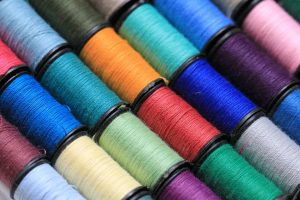In everyday fabric and yarn handling, terms related to thickness, such as “Count” and “Denier” , are frequently encountered. There are several units to express the thickness of yarn, but what are the differences among them? In this instance, I would like to delve into how yarn thickness is represented.
I am Yu Yamamoto from the TAILORS WORLD editorial team.
目次
The Definition of Yarn Thickness
When working with fabrics and threads, terms like denier and tex, indicating thickness, are commonplace. Exploring the nuances of yarn thickness is essential for understanding fabric texture. Yarn thickness is often expressed in denier or tex. Denier measures the weight of a 9000m length, with higher denier indicating thicker yarn. Tex, adhering to ISO standards, measures yarn weight per 1000m or 10000m, influencing thickness.
What is Denier?
Denier is a unit used for filament yarn (continuous long fibers), indicating the weight of 9000m of yarn. If 9000m weighs 1g, it’s 1 denier, and 50g would be 50 denier. Higher denier numbers represent thicker yarn. Filament yarn consists of continuous long fibers, either natural (like silk) or synthetic.
Understanding Tex
Recently, tex (and dtex) has become more prevalent, aligning with International Organization for Standardization (ISO) standards. Tex is a unit applicable to all yarn, measuring weight per 1000m, while dtex uses 10000m. Higher numbers denote thicker yarn, providing a versatile measurement system applicable to all types of yarn.
Short Staple Yarn and Tex
Short staple, or staple fiber, refers to short fibers, such as cotton or wool, typically a few centimeters in length. The unit for measuring yarn thickness in staple fibers is “count,” indicating how much length (in yards) corresponds to a fixed weight (in pounds). However, comparing counts between filament and staple yarn can be misleading, given different standards and materials.
Dtex and Its Growing Popularity
In line with ISO standards, tex and dtex (decitex) are increasingly used. Tex measures yarn weight per 1000m, while dtex uses 10000m, both providing a universal measurement. As with denier, higher dtex values represent thicker yarn, making it adaptable for various yarn types.
Natural Fiber Thickness
Natural fibers exhibit intrinsic thickness characteristics. Ramie, the thickest, is followed by wool, linen, cotton, and silk. Thinner fibers result in denser and lighter fabrics, while thicker fibers lend themselves to breathable weaves.
Considerations for Choosing Yarn Thickness
Choosing the right yarn thickness is crucial, considering the type of fiber, fabric handling, and sewing techniques. The same numerical value may represent different thicknesses when expressed in denier, tex, or dtex. Attention to units is paramount in ensuring the desired outcome in fabric construction and garment making.
Conclusion
We have learned that the thickness of yarn is referred to by various names depending on the type of fiber. Even with the same numerical value, the thickness can vary significantly in denier, count, and decitex, so attention must be paid to the units. It becomes crucial to alter the material and thickness of the thread based on the fabric and sewing techniques employed.
For orders, inquiries related to the content above, or questions about accessories and sewing services, please don’t hesitate to contact
After 2 years of training at a major order-made suit store in Japan, I started my career in apparel materials and fabrics.
I’m especially good at suits and coats.


